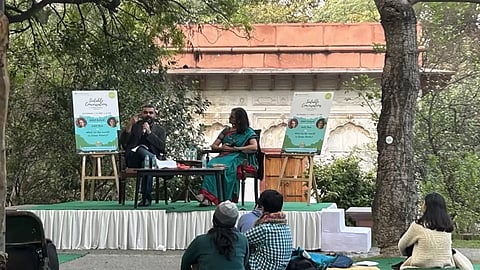Often, when we talk about queerness, we see it as an umbrella term for the LGBTQIA+ community. We forget that labels and categories indicate a closed understanding of the word ‘queer’ given by heteronormative society. When ‘queer’ is put before poetry, it becomes an even more complicated association, for poetry, similar to queerness, cannot simply be restricted to verses and stanzas, and rhymes and alliterations.
Queer Poetry And Beyond
Queer poetry, as one begins to understand it, cannot be contained within the five letters of the word. It is far more complex and encompasses a greater cause and a wider range of subjects.
So, what must a poem have to make itself worthy of a slot in the genre called ‘queer poetry’? Does it have to have rainbow colours that soothe a broken heart, or scream resistance at the top of the lungs? Would it qualify as a queer poem if the poet was not out and proud? Or if they were out and proud but wanted to write about something else? Is it queer only when written by a queer-identified person about queer themes, whatever those maybe? Can a non-queer person not address these themes as well?
What in the world is queer poetry? In the heart of Delhi, surrounded by lush green gardens and Mughal tombs, with birds chirping in the background, at Sunder Nursery, poet, queer activist and scholar Akhil Katyal and essayist, activist and poet Aditi Rao attempt to answer it in a conversation hosted by A Suitable Agency.
Years back, Katyal says, he tried to pose these questions to Hoshang Merchant, who is considered a pioneer of queer poetry in India. “He had given us a series of answers, some of which contradicted each other…Queer turned out to be both an embodied experience available to some people, but also a disembodied stance towards the world wielded by many.”
“Queerness is an identity but also a worldview; it is also a lens through which many things are happening in a life,” he says.

Queer poetry, as one begins to understand it, cannot be contained within the five letters of the word. It is far more complex and encompasses a greater cause and a wider range of subjects.
As a genre, queer poetry often explores themes related to the experiences, identities, and emotions of individuals who identify with the LGBTQIA+ (lesbian, gay, bisexual, transgender, queer, and other non-heteronormative identities) spectrum. It typically delves into subjects like love, desire, identity, discrimination, and societal expectations from a non-heteronormative perspective. This does not necessarily mean that the individual identifies themselves as “queer”, for queer is also only one of the many identities in the spectrum.
Akhil Katyal speaks about an anthology titled The World That Belongs To Us: An Anthology of Queer Poetry from South Asia that he and Aditi Angiras put together, and opens up about how as editors, they struggled when it came to deciding the title and description that goes on the cover page of the book. He says that after a lot of discussion, they ultimately decided to use the word ‘queer’ but also realised the contradiction to using it as an umbrella term.
“We realised that just saying queer would exclude so many other identities that the authors also identify with,” he said.
As a result, they decided that the preface of the anthology ensures that transgender, non-binary, Dalit, Muslim, indigenous and other voices, that are often marginalised in mainstream queer spaces, get to have their say.
As Rao delves into the decriminalisation of Article 377, a historic moment for the LGBTQ community in India, she asks Katyal about how his poetry has shifted over time in terms of queerness taking centre stage. Katyal, who also teaches at Ambedkar University, answers this using what he calls two classroom phrases—synchronic and diachronic. Synchronic means something that happens at one moment, whereas diachronic is something which has developed or evolved.
“In my journey, I realised that queerness functioned very differently synchronically and diachronically. At some point in your life, queerness was everything there was because, till that point, it had been a subject of fear, anxiety, being bullied; a subject of secrecy. And the great thing about secrecy is it makes you think very disproportionately about yourself.
“What happened later on, as this initial intensity faded off, is that queerness became just one of the many things I identified with, in the world,” he says. It was no longer limited to people who share the same bodily desires as him and he adds that references in history such as poets like Dorothy Parker, Amrita Pritam and Aga Shahid Ali “were just as queer” to him as someone who may share this thing called "gayness" or "lesbian-ness".
“Queerness was no longer a thorn in the shoe but became one of the many things which I have. It became one of my dimensions.” He goes on to say that people also write white literature, heterosexual literature and upper-caste literature but they are usually not named as such. “Some attributes are given the limitation of being a constraint and some attributes are considered universal. One began to question that distinction.”
Queer poetry is hardly a new phenomenon but with the societal acceptance of the LGBTQ community, especially in the traditional structures of the South Asian community, there is a new wave of queer poets showcasing their voices that have been hushed so far.
What many wonder and often question is why we cannot call queer poetry simply poetry. After all, queer poets delve into many of the same themes that non-queer poets do, like love, desire, discrimination, expectations. What is the need to categorise it? Aditi Rao says, perhaps the need arises because there is still a lack of acceptance in society. “Queer poetry, similar to women poetry, is still fighting for its place in this world. Perhaps we haven’t reached that stage yet, the ultimate goal, where it becomes universally accepted, and not differentiated.”